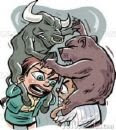
How to use volumes…. This itself is long enough to write a few articles… :P first of all, how to use volumes depends on what method you are adapting to…. to start from basic, volume is formed when transaction is done… every transaction or every volume means an agreement of price between buyers and sellers…. Volume is like and indicator for the sustainability of trend…. To make it simple, it is like fuel for the flame… the flame represents the trend, no matter up or down… so, if you see volume dying down, it shows signs of dying flame too…. and vice versa… simple? :P
Now, homework….
1) Are the statements correct?
a. Low volume equals illiquid.
b. Low volume equals price is about to drop.
2) What is true low volume and what is relative low volume? What is the significance?
Ok, lets go a bit deeper, if we are using trends or phases… how do we incorporate volume into them? Basically, we can generally divide the trend into three types or phases:
3) Uptrend
4) Downtrend / Distribution
5) Range bound
How does volume come in? Well, as stated above, when we see price moving uptrend, a healthy one will be accompanied with increasing volume because this means more people agree and supports the increasing price… so we can say it is sustainable…. and vice versa…
How about range bound? during range bound, volume is also normally in range… why? Because less transactions involved… now, towards the end of range, volume will pick up… because there will be more and more people involved and more transactions are being done… this is called public participation…
Homework:
1) Does public participation or volume picking means that uptrend is next?
2) Revise a bit on supply Vs demand.
Ok, stop here first, leave the deeper stuff for later… :P do post your answers and questions if you don’t understand or require further information…
Regards and happy learning
Now, homework….
1) Are the statements correct?
a. Low volume equals illiquid.
b. Low volume equals price is about to drop.
2) What is true low volume and what is relative low volume? What is the significance?
Ok, lets go a bit deeper, if we are using trends or phases… how do we incorporate volume into them? Basically, we can generally divide the trend into three types or phases:
3) Uptrend
4) Downtrend / Distribution
5) Range bound
How does volume come in? Well, as stated above, when we see price moving uptrend, a healthy one will be accompanied with increasing volume because this means more people agree and supports the increasing price… so we can say it is sustainable…. and vice versa…
How about range bound? during range bound, volume is also normally in range… why? Because less transactions involved… now, towards the end of range, volume will pick up… because there will be more and more people involved and more transactions are being done… this is called public participation…
Homework:
1) Does public participation or volume picking means that uptrend is next?
2) Revise a bit on supply Vs demand.
Ok, stop here first, leave the deeper stuff for later… :P do post your answers and questions if you don’t understand or require further information…
Regards and happy learning





